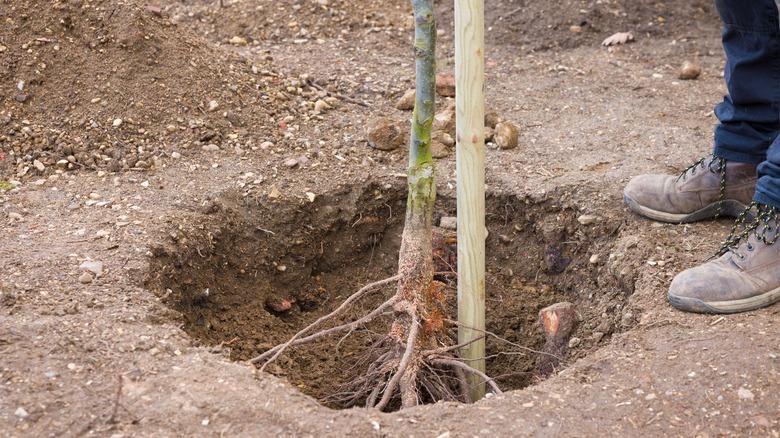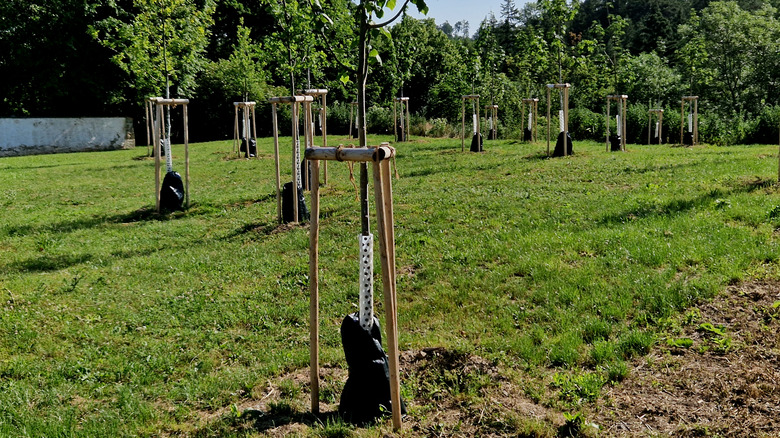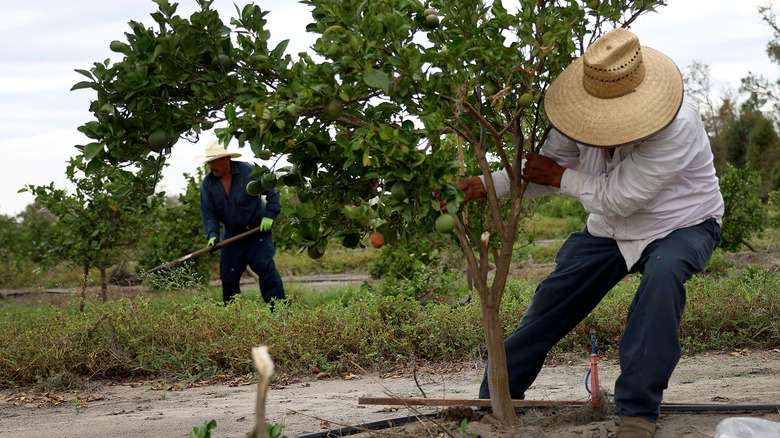The Best Time To Remove Stakes From Your Newly Planted Trees
Planting a new tree can be exciting and, naturally, you want to do everything right. Though you may have successfully grown many plants in the past, growing a young tree is quite different. The biggest difference is size. Potted plants, even larger ones, are a bit easier to plant carefully so they grow straight while doing the same for a tree may require reinforcements. One such aide can be a stake. The ideal time frame to remove a stake depends on the tree, though there is a general range guideline. In short, you should remove a stake from a newly planted tree when it is ready to stand straight on its own. This timeframe can vary anywhere from six months to two years.
Stakes should ideally be added at the time of planting. Keep in mind, that this common tree-planting practice isn't always necessary, and not all new trees need stakes. Stakes are needed to help those trees that can't stand up straight on their own to stay upright. Typically the trees that benefit from staking are ones that bend after being planted and those that have small roots. The staking will support the young trees until they can grow a robust root system to support them. If the trees are in a very windy area, staking can help guard against being uprooted.
Leave stakes in place long enough
Stakes work best to help support young trees and can certainly help straighten a leaning tree in your yard but they shouldn't be relied upon as a long-term solution. The idea is to help the tree get established and give it some time to grow to support itself. Generally speaking, a small plant usually does well with stakes for a year after going through one full season of growth. Some smaller trees may even be ready to have stakes that were added in the spring removed in the fall. However, larger trees may need two years to get properly rooted.
You want to ensure that your tree has had enough time and is ready before you remove its stakes. First, untie the ties from the tree to the stake but leave the stakes in the soil. Then test the tree to determine how firm it stands alone. If the tree bends or is very wobbly, it is not time to remove the stakes yet and you can just tie the tree back to the stakes. You should never remove stakes unless you are sure the tree is ready because removing it and then putting it back can diminish the progress and disturb the young roots. If the tree is steady, proceed to remove the stakes. Make sure you remove the ties or straps from around the tree trunks, too. Leaving them on can inhibit trunk growth and they can dig into the tree.
Avoid leaving stakes on too long
Just like you don't want to remove stakes too early, you also don't want to leave stakes in too long. Stakes that accompany a growing tree longer than they should can inhibit the necessary trunk tissue from building on its own. In these cases, the trunk tissue may grow too slowly because the tree is relying on the stake for strength more than itself. This can result in a weak tree that can't stand alone without support.
If you check a tree and determine that the stake is not ready to be removed, make sure to recheck at regular intervals. This is important so it doesn't stay staked any longer than it has to which, besides weakening the tree can also lead to the trunk outgrowing its ties. If the ties become tight around the tree, add new, longer ones so they won't impede the trunk's growth. That is one reason why you never want to use a wire to strap the tree to the stake. When wires tighten they can prevent the trunk from getting necessary water and nutrients and hinder the ability to distribute those crucial elements to the rest of the tree. Opt for canvas materials, upcycle an old garden hose, or choose biodegradable ties.


